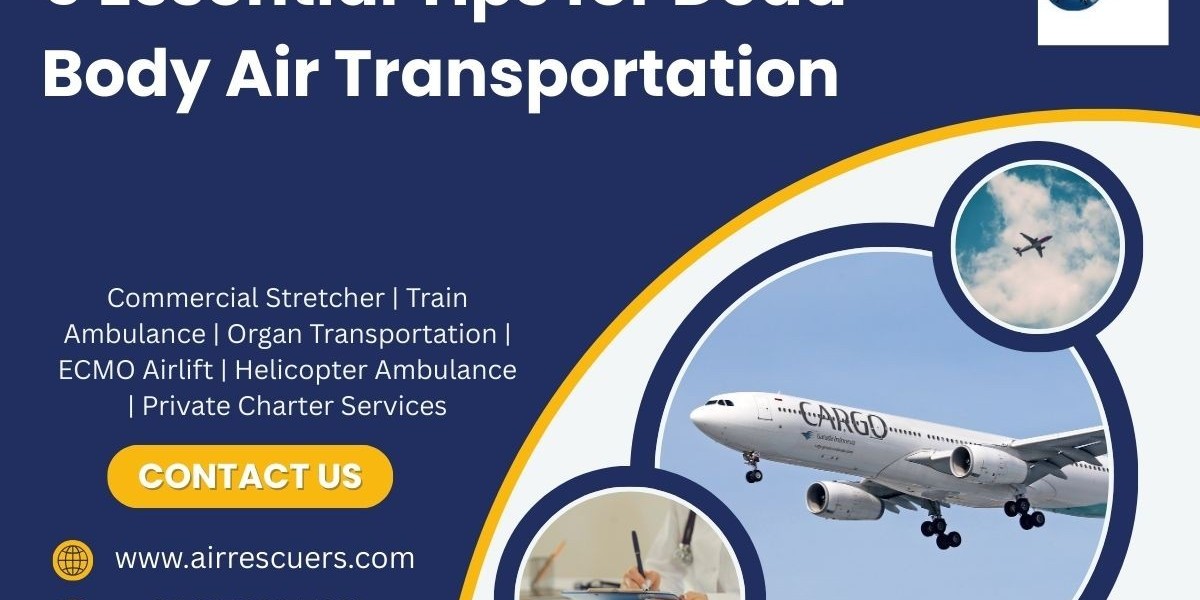The loss of a loved one is one of the most difficult experiences a family can endure. While dealing with grief, there are also practical responsibilities that must be taken care of, especially when the deceased has to be transported from one location to another. In many cases, families face the challenge of arranging for the transportation of mortal remains by air—whether it is within the country or across international borders.
Dead body air transportation, often referred to as air repatriation, is a highly sensitive process that requires compassion, professionalism, and strict adherence to legal and medical protocols. Unlike the transportation of living patients, this procedure involves multiple steps, such as obtaining documentation, preparing the body, coordinating with airlines, and ensuring cultural or religious rituals are respected.
If you ever find yourself in such a situation, being aware of the process can help reduce stress and prevent unnecessary complications. To guide you, here are 5 essential tips for dead body air transportation that every family should know.
1. Understand the Legal and Documentation Requirements
Transporting a deceased person by air involves strict legal procedures to ensure proper identification and compliance with aviation and health regulations. Before any arrangements are made, families need to obtain specific documents that vary depending on whether the transport is domestic or international.
For domestic transportation within India, the required documents usually include:
Death certificate issued by a registered medical authority.
Embalming certificate (if required by the airline).
NOC (No Objection Certificate) from local police or relevant authority.
Identity proof of the deceased and family members handling the process.
For international repatriation, additional documents may include:
No Objection Certificate from the Indian Embassy/Consulate (if transporting abroad).
Clearance from the immigration department.
Import permit or authorization from the destination country.
Passport of the deceased (cancelled after death is confirmed).
Failure to obtain the proper paperwork can cause delays or even denial of transportation. Families should therefore consult experienced service providers or embassy officials to ensure everything is in order before the journey begins.
2. Choose the Right Air Transportation Service
Not every airline or service provider is equipped to handle the delicate process of transporting human remains. This is why choosing a specialized provider is crucial. Professional air ambulance or repatriation services are trained in handling such situations with dignity and respect.
When selecting a service, consider the following factors:
Experience and Reputation: Look for providers with a proven track record in handling dead body transportation.
Network and Coordination: A reliable service should have strong ties with airlines, hospitals, embassies, and local authorities.
24/7 Availability: Emergencies don’t follow a schedule. A good provider should be available around the clock.
Transparency in Costs: Families are already under emotional and financial strain. Ensure that the pricing is fair and transparent, with no hidden charges.
One well-known provider offering such support is AirRescuers, which has experience in managing domestic and international dead body transportation with professionalism and compassion.
3. Prepare the Body with Care and According to Guidelines
Preparing the body for air transportation is one of the most crucial steps in the process. It must be done in accordance with health and aviation regulations to ensure the safety of other passengers and crew members.
The preparation typically involves:
Embalming: This process preserves the body for longer durations and prevents decomposition during travel. In most international cases, embalming is mandatory.
Sealed Coffin: The body is placed in a coffin that is hermetically sealed to prevent leakage of fluids or escape of gases.
Coffin with Outer Packaging: Many airlines require an additional outer wooden box for safe handling and storage.
Temperature Control: In some cases, refrigeration units may be used prior to the flight to maintain the condition of the body.
It is important to note that embalming and sealing must be done by authorized professionals, as improperly prepared remains may not be accepted by airlines or immigration authorities.
4. Coordinate Logistics in Advance
Dead body transportation is not a simple one-step process. It involves coordination between multiple parties, including hospitals, police departments, airlines, ground handling teams, and the receiving family at the destination. Any misstep in this chain can cause delays, which may be distressing for the grieving family.
Key logistical points to consider include:
Booking the flight in advance and confirming that the airline is equipped for human remains.
Ensuring ground transportation is arranged both at the origin and the destination.
Coordinating with the receiving party to confirm availability of hearse vans, mortuaries, or cremation/burial arrangements.
Checking baggage rules for human remains, as airlines have strict protocols for handling coffins or caskets.
It is highly advisable to hire a professional repatriation service provider who can handle the complex logistics and provide a seamless experience for the family.
5. Be Mindful of Cultural and Emotional Needs
Beyond the legalities and logistics, transporting a deceased loved one is also an emotional and cultural process. Families often wish to perform rituals according to their faith, and these considerations should be respected during transportation.
Some cultures have specific timelines for funerals or cremation, making timely transport essential. Others may have rituals that must be performed before sealing the coffin. Service providers should be sensitive to these needs and work closely with the family to ensure their wishes are honored.
Moreover, emotional support during this time is just as important as logistical assistance. Families may feel overwhelmed by the procedures, and having a compassionate team to guide them through the journey can make a tremendous difference.
Conclusion
Transporting the mortal remains of a loved one by air is a complex process that combines legal, medical, logistical, and emotional aspects. While it is never easy to go through, being aware of the steps involved can help families make informed decisions and avoid unnecessary stress.
To recap, here are the five essential tips for dead body air transportation:
Understand and complete all legal and documentation requirements.
Choose a trusted and experienced transportation service.
Ensure proper preparation of the body according to regulations.
Coordinate all logistics well in advance.
Respect cultural, religious, and emotional needs throughout the process.
By keeping these factors in mind, families can ensure that their loved one’s final journey is handled with dignity, respect, and care. With professional assistance, such as that provided by specialized services in Chennai and across India, families can focus on grieving and remembering their loved ones while experts handle the sensitive details of repatriation.
In moments of loss, having the right guidance and support can ease the burden, ensuring that the departed are brought home with honor and compassion.







